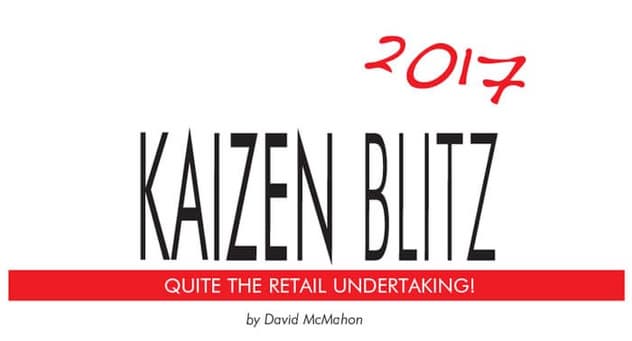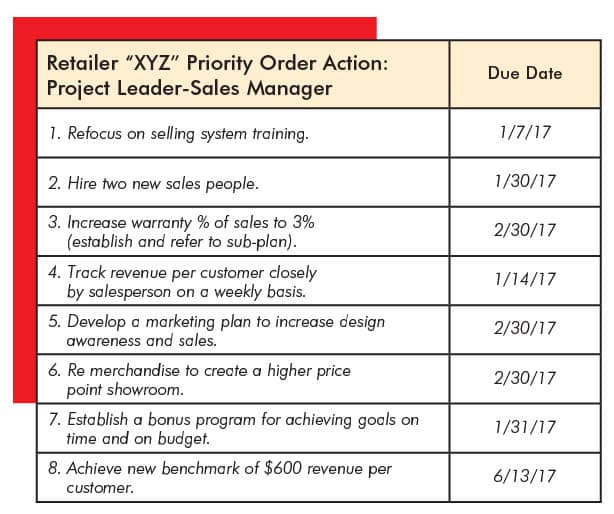
Here’s how to hold a short-term Kaizen Blitz event in 2017 to propel increased efficiency and effectiveness in your furniture store operation.”
The most common success trait required for long-term retail prosperity is a real, organization-wide commitment to continual improvement.
It sounds simple, but it’s actually quite a big undertaking. Continuous improvement involves ongoing self-analysis. It requires seeking constant and oftentimes transformative change, and it takes a significant investment both in time and money. Anyone can say they have the discipline to continuously improve, but only the exceptional actually take the risk to execute properly. Generally there are three types of retailers:
- Those who watch for change and then follow.
- Those who avoid change and let things happen around them.
This article is for those who are actively seeking change for the better. This trait allows these businesses to stay relevant and attract more customers. They are able to develop long-term employees who are engaged, and attract new talent. It allows them to grow sales volume and produce profits in all economic situations. Those who seek change are more often ahead of the curve, and they reap the benefits from being proactive as opposed to reactive.
Perhaps the best ideology of change is known as Kaizen. In Japanese, Kaizen translates to Kai = Change and Zen = Good. Its roots are in post WWII manufacturing at Japanese companies like Toyota. Subsequently Kaizen was adapted and refined to propel efficiency and effectiveness the world over in many types of businesses and industries.

I have a Kaizen practice adapted for use in retail field operations called Kaizen Blitz (or Kaizen Event). What follows is an adaptation of Kaizen Blitz that Furniture World’s readers can use to implement continuous improvement. Kaizen Blitz can open the doors to greater opportunities and transform your organization. To understand the difference between Kaizen and a Kaizen Blitz, think of Kaizen as the macro philosophy; a long-term never-ending way of thinking. Now, think of a Kaizen Blitz as a short-term exercise that usually takes place in under one week. Its purpose is to focus on an area of a retail operation, analyze its current state, and then execute new systems to improve the future state.
Setting The Stage
Some preparation in advance is necessary to conduct the most effective Kaizen event. Many entrepreneurs want results fast, and don’t like to waste time waiting around. While it’s great that they want results, haste can actually waste much more time and produce lower quality results. Therefore, spend some time wisely in advance of your Kaizen Blitz.
Here are some components that should be in place:
#1: Designate The Facilitator
Every project needs one owner. A Kaizen event is no different. What is different here, however, is that the leader for a Kaizen Blitz should be a unbiased facilitator. A manager, owner, or even an employee in a seemingly unrelated department may be influenced by personal perspectives. So, for best results, find someone from outside of your company who possesses a high-level understanding of the various inter-related aspects of operations (i.e. marketing, selling, purchasing, inventory, distribution, CRM, service, IT, financial control, and analysis) to facilitate the event.
#2: Define Focus & Scope
It is always best to focus on one area of an operation at a time. Being scattered, unfocused and getting side-tracked can hinder the reveal of potential opportunities and conceal the root of the challenge at hand. To really dig-in, the proper amount of time and effort should be invested. For example, if you want to grow sales per customer encountered, that needs to be the primary area of concentration. You must really look at all the elements impacting that metric. Don’t get distracted by non-related factors, and avoid tiny exceptions.
During the several days that a Kaizen event takes place, it is possible to focus on multiple organizational areas. My main advice here is to make sure the primary objective is accomplished before moving on to another area. If you wish to dive into improving your GMROI through stock-replenishment systems as a secondary focus, make sure everyone involved is on-board with solutions for the prime focus first. Keep your scope within reason. It is better to get one thing done right, than to realize several half-baked solutions.
#3: Choose the Participants
The kinds of team members who participate in a Kaizen event will differ from retailer to retailer. Generally though, participants are top and middle managers with some involvement from line-level employees. A general rule of thumb is that those who should be present in these improvement meetings are people who “own” the existing procedures, who understand how the procedures affect other areas of the organization, who execute related daily tasks, and can make change decisions.
Participants need to keep focused, so keep the improvement team to a number that makes sense. Too many people can cause distraction, while too few may become too insular. If needed, the leader can interact with people in shifts for better organization.
Now that you have the preparation for the improvement event covered, you are ready to address the core items of a Kaizen Blitz. If you have read previous articles in this series on LEAN operations, you will notice similarities in the approach.
#4: Analyze & Measure
The first step is to get an overview of the situation. This is accomplished in two ways:
- Discuss and question your stake-holders.
- Check your retail performance metrics.
The leader of a Kaizen event needs to understand how things currently work. There should be an open forum for discussion. Questions should be asked, such as:
- What are your current systems? What are your challenges?
- What do you think can be done to improve this?
- Who is involved with this function?
- What else in the business does this effect?
- This qualitative approach is often just as revealing as looking at the numbers.
Checking performance metrics is the quantitative approach allowing for points of measurement of the current state. Look at all of the available data. Start with the high-level results and then get more detailed. If you are seeking to improve revenue per opportunity, you might also measure:
- Written and delivered volume change
- Number of customers month to month
- Sales per square foot, sales per employee
- Special order sales
- Gross margin and everything by salesperson as well.
Benchmark against past performance and against industry peers. Improvement starts with measurement.
The above exercises will always reveal opportunities for improvement. This naturally leads into the next part of a Kaizen Blitz.
#5: Prioritize, Plan & Assign
- Based on what is revealed in the investigation stage, Kaizen participants will need to decide on priorities and solutions. What metric will you seek to move, and more importantly, what will you do, who will do it and when will it get done?
For instance, with the focus on improving revenue per opportunity, the possible actions you might come up with could include:
- Hiring additional sales staff.
- Improving the selling skills of the current staff.
- Changing the merchandising structure.
- Expanding the design program.
- Improving warranty sales.
- Focusing marketing efforts on return customers.
Great, now document what will be done first and who will champion the initiative. Every Kaizen Blitz undertaking requires that the responsibility of managing execution be designated to one person. That does not mean that they’ll be the only one individual working on the initiative. It does mean that one person will be in charge of managing the system to achieve desired results.
#6: Execute to Conclusion
Actualizing results is the step separating star performers from the rest. Success often rests on the follow-through abilities of top managers and business owners. You cannot expect an employee to do everything you ask them to do... not in the world I live in anyway. You can state your expectations, and get all the head nods in the world, but that will not necessarily result in adequate execution. Execution requires:
- Often the investment of dollars.
Execution requires follow-through.
Kaizen Initiative Example
An outline for a sample Kaizen Initiative for increasing revenue per opportunity for furniture can be found in the chart on page 100. The goal for retailer “XYZ” is to increase revenue per customer opportunity in 2017 to a $600 monthly average from $500 which was the monthly average for 2016.
When setting up this initiative for retailer “XYZ”, a progress review schedule was set up to track and report:
• Weekly at operations meetings
• Monthly at an all company meetings
• Monthly at sales team meetings.
A target completion date was set as well, for June 30, 2017, six months from the start date of January first.
Continuous Review
The final phase in any Kaizen event is to do it all again. Once one goal has been achieved, look to another area. Continuously seek improvement throughout the organization and conduct another Kaizen Blitz.
In continually improving retail operations it is likely that several improvement projects will be going on simultaneously. Ensure that you follow-up on all projects. Continue to watch important metrics of past and present initiatives to avoid slipping back into old habits. Track the progress of each improvement project individually, but review together in your operations meetings. One project likely affects other projects as the systems and processes in an organization are integrated. Make sure each department in the organization has its priorities established.
Keep pushing forward, drive change, reward success and overall results will follow.